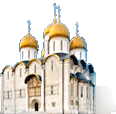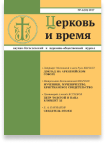Issue I of the magazine ‘State, Religion and Church Within and Outside Russia’ for 2015 publishes the findings of the study project ‘Development of a New Methodology of Dialogue and Cooperation between Religion and Science in Russia’ carried out in 2013-2014 by the Chair of Social Sciences of the Ss Cyril and Methodius Institute of Post-Graduate Studies (CMI). The results of the project are summed up in an article written by the CMI staff members who supervised the project, A. Kyrlezhev, A. Shishkov, V. Shmaliy. Dialog religii i nauki: novye podkhody (itogi discussii)//Gosudarstvo, religiya, tserkov v Rossii i za rubezhom. 2015 No. 1 (33), pp. 164-183.
Annotation
In the article written by the supervisors of this study project supported by the John Templeton Foundation, the discussions held under the project are summed up. The authors stress that the epistemologist approach traditional for dialogue between science and religion in a Christian culture should be broadened and made more complex by using other approaches to the science-religion relationship, such as historical and cultural, sociological and an approach made from the perspective of the ethos of the scientific and religious community. This extension is dictated by both the actual religious-social processes and the specific post-Soviet transition. Science and religion represent not only different cognitive attitudes but also specific social institutions and cultural traditions. At present, religion and science meet in a situation of crisis in the modern paradigm of functional differentiation of the socium that presupposes their mutual autonomy: while religion becomes publicly significant again, science appears to partly lose its cultural hegemony. The development of their dialogue presupposes new perspectives: juxtaposition of the metaphysical foundations of science and religion and, accordingly, religious and secular outlooks; consideration for macro- and micro-social context that produces scientific and religious experience/knowledge; encounter and interaction between theology and humanities and social sciences. The authors insist on the counter-productive nature of radial strategies which either assert the absolute autonomy of both science and religion or create a certain scientific-religious synthesis, since these strategies exclude the very possibility of a dialogue between science and religion as different cognitive attitudes and cultural spheres which preserve independent significance in a common socio-cultural space.
The full text (in Russian) is available on the website of the magazine ‘Gosudarstvo, religiya, tserkov v Rossii i za rubezhom’.
CMI Press Service






